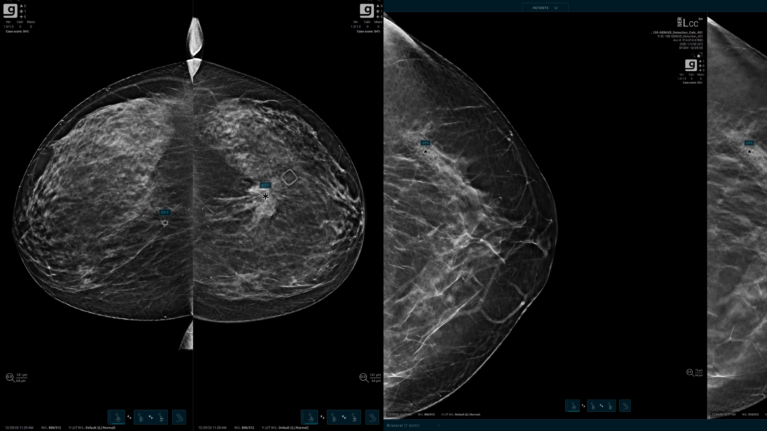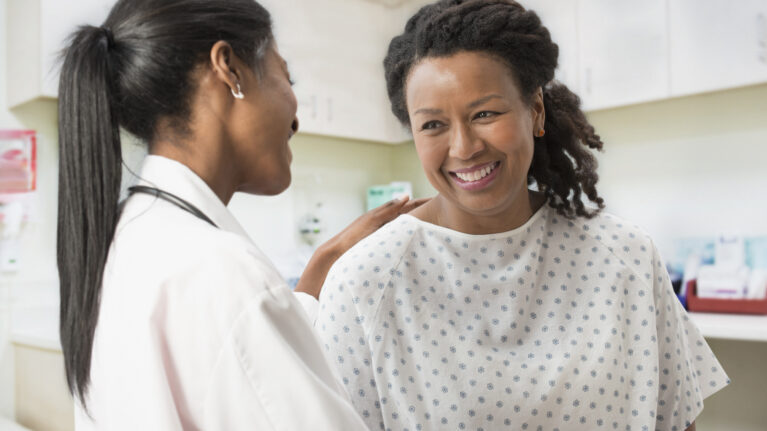Dense Breast News For Every Boob: New FDA Screening Regulations

You may have heard us talk a LOT about breast density. But what exactly does that mean? It’s a good question! Especially because nearly 50% of women actually fall into the dense breast category1 (and most might not even know it).
Breast Density 101
Breasts are made up of several different tissue types including glandular, fibrous, and fatty tissues. When you have dense breast tissue, that means your tissue is more fibrous and glandular than fatty. A lot of factors can cause breast density, like your genetics, hormones, and your age to name a few.
This doesn’t mean there’s anything wrong with your breasts! But breast density can make it harder to find breast cancer during a mammogram screening. Why? The dense tissue can obscure tumors and make them harder to find on a traditional mammogram, since they both appear white.
So, how do you know if you have dense breasts? You can’t feel dense tissue by yourself during a breast self-exam, and neither can your doctor during your clinical breast exam. Only a radiologist looking at a mammogram can tell if a woman has dense breasts.2 That’s why it’s SO important to be in the know about breast density and speak to your doctor to find out the kind of tissue you might have.
Understanding Breast Density Could Save Your Life
Across the country, 38 states recognize you deserve to be informed, so they require patients to be notified about breast density and what it means for mammograms and finding breast cancer. You can learn about your state’s legislation here. More good news is that the FDA is now following suit and planning new regulations for the entire country on mammograms to help those with dense breasts get the *breast* healthcare they deserve.
“‘If the FDA passes this ruling, [the] United States will have this legislative piece mandating that all women in the US are informed of their tissue type (whether they have dense breasts),’” said Dr. Georgia Spear, Chief, Department of Breast Imaging, Northshore University Hospital. ‘[Women] can be proactive in seeking additional screening that may be necessary to find their cancer at an early stage.’” She also added that this would be, ‘amazing and so necessary.’”3
How The Genius® 3D Mammography™ Exam Makes a Difference
Now that you’re up-to-date with all things breast density, let’s chat about scheduling a better mammogram. The Genius® 3D Mammography™ exam is the only mammogram approved by the FDA as superior for women with dense breasts.4,5 And that’s great news for your health! Even if your breasts are dense, the Genius® exam finds 20-65% more invasive breast cancers compared to 2D alone, an average increase of 41%.6
After all, knowing more about breast density and screening options for breast cancer gives you the power to make better breast health choices—and increased chances of early detection can save more lives. Read more about the benefits of early detection.
SOM-01429
Disclaimers:
The content in this piece is for information purposes only and is not intended to be medical advice. Please contact your medical professional for specific advice regarding your health and treatment. This information may be relevant in the U.S. and other markets and is not intended as a product solicitation or promotion where such activities are prohibited. Because Hologic materials are distributed through websites, eBroadcasts and tradeshows, it is not always possible to control where such materials appear. For specific information on what products may be available in a particular country, please write to womenshealth@hologic.com.
The Genius® 3D MAMMOGRAPHY™ exam (a.k.a. Genius® exam) is acquired on the Hologic® 3D Mammography™ system and consists of a 2D and 3D image set, where the 2D image can be either an acquired 2D image or a 2D image generated from the 3D image set. The Genius exam is only available on the Hologic 3D Mammography system. Please consult your physician for a complete list of benefits and risks associated with mammography.
Hologic, 3D, 3D Mammography, Genius, and associated logos are trademarks and/or registered trademarks of Hologic, Inc. and/or its subsidiaries in the United States and/or other countries.
-
1. National Cancer Institute. (2020, July 14). Dense breasts: Answers to commonly asked questions. Dense Breasts: Answers to Commonly Asked Questions. https://www.cancer.gov/types/breast/breast-changes/dense-breasts.
2. Dense Breasts: Answers to Commonly Asked Questions. National Cancer Institute. https://www.cancer.gov/types/breast/breast-changes/dense-breasts#what-are-dense-breasts. Accessed January 2023.
3. FDA plans new regulations on mammograms in effort to help women with dense breasts. CBS News. https://www.cbsnews.com/news/breast-cancer-mammograms-fda-dense-breast-tissue/. Accessed January 2023.
4. FDA submissions P080003, P080003/S001, P080003/S004, P080003/S005.
5. Friedewald SM, Rafferty EA, Rose SL, et al. Breast cancer screening using tomosynthesis in combination with digital mammography. JAMA. 2014 Jun 25;311(24):2499-507.
6. Results from Friedewald, SM, et al. “Breast cancer screening using tomosynthesis in combination with digital mammography.” JAMA 311.24 (2014): 2499-2507; a multi-site (13), non-randomized, historical control study of 454,000 screening mammograms investigating the initial impact the introduction of the Hologic Selenia® Dimensions ® on screening outcomes. Individual results may vary. The study found an average 41% (95% CI: 20-65%) increase and that 1.2 (95% CI: 0.8-1.6) additional invasive breast cancers per 1000 screening exams were found in women receiving combined 2D FFDM and 3D™ mammograms acquired with the Hologic 3D Mammography™ System versus women receiving 2D FFDM mammograms only.


